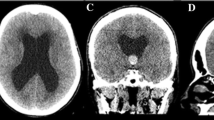Abstract
We present the case of a patient who died of a fatal meningoencephalitis after removal of a third ventricle colloid cyst. Postoperative clinical and iconographic evolution let us think about an acute disseminated encephalomyelitis probably due to cerebrospinal fluid contamination by inflammatory proteins contained in the colloid cyst. This case raises the question of a possibility of colloid cyst content spraying while using an ultrasonic aspiration device.



Similar content being viewed by others
References
Barber SM, Rangel-Castilla L, Baskin D (2013) Neuroendoscopic resection of intraventricular tumours: a systematic outcomes analysis. Minim Invasive Surg 898753
Cinalli G, Imperato A, Mirone G, Di Martino G, Nicosia G, Ruggiero C, Aliberti F, Spennato P (2017) Initial experience with endoscopic ultrasonic aspirator in purely neuroendoscopic removal of intraventricular tumour. J Neurosurg Pediatr Mar 19(3):325–332
Desai KI, Nadkarni TD, Muzumdar DP, Goel AH (2002) Surgical management of colloid cyst of the third ventricle: a study of 105 cases. World Neurosurg May 57(5):295–302
Garg RK (2003) Acute disseminated encephalomyelitis. Postgrad Med J 79:11–17
Kuchelmeister K, Bergmann M (1992) Colloid cysts of the third ventricle: an immunohistochemical study. Histopathology Jul 21(1):35–42
Oertel J, Krauss JK, Graab MR (2008) Ultrasonic aspiration in neuroendoscopy: first results with a new tool. J Neurosurg 109:908–911
Refai D, Lee MC, Goldenberg FD, Frank J (2005) Decompressive hemi-craniectomy for acute disseminated encephalomyelitis: case report. Neurosurgery 56(4):E872
Rodriguez-Porcel F, Hornik A, Rosenblum J, Borys E, Biller J (2014) Refractory fulminant acute disseminated encephalomyelitis (ADEM) in an adult. Front Neurol 5:270
Veerman EC, Go KG, Molenaar WM, Amerongen AV, Vissink A (1998) On the chemical characterization of colloid cyst contents. Acta Neurochir 140(4):303–306
Author information
Authors and Affiliations
Corresponding author
Ethics declarations
Conflict of interest
The authors report no conflict of interest.
Additional information
Comments:
The authors present the unfortunate case of a fatal complication due to the use of intraoperative ultrasonic aspiration in endoscopic neurosurgery. Without wanting to criticize the authors unduly for their choice, this is an important publication which one may read as a warning against the indiscriminate use of technical devices or additives during surgery. Just because we have the equipment doesn’t necessarily mean that its use will be more beneficial than harmful to the patient.
At least three questions should be asked before applying any technical device during surgery: (1) what is the benefit to be expected, (2) what will be the added risks and (3) are there alternatives? For endoscopic neurosurgery with its issues concerning visibility, orientation and limited maneuverability, the answers to those questions are even more crucial than for microscopic neurosurgery. In the current case, no additional benefit from the use of ultrasonic aspiration was to be expected since the lesion was cystic and therefore nothing needed to be broken down into pieces. If there was no additional benefit then what was left was only the potential for additional risks even if their nature may have been unknown at the time. It seems that alternative resection aides such as waterjet dissection or laser mediated photo-vaporization were rightfully not considered since their use was obviously deemed not reasonable, unnecessary or potentially even more harmful. In view of the current case report, it has to be stated that a cystic lesion located in the third ventricle can be well removed endoscopically using standard instruments only.
Another example of the detrimental application of ultrasonic aspiration is its use during the resection of brain metastases. Evidently, in those cases ultrasonic aspiration leads to a greater spread of tumour cells resulting in a higher risk of meningeal seeding with unnecessary and harmful long-term sequela for the patient (1).
The potential for additional technology-specific risks and hazards is not exclusively limited to ultrasonic aspiration. In neurosurgery, other technologies may have the potential to be harmful as well if not selected appropriately such as radiosurgery, aneurysm clipping or neuro-endoscopy to mention just a few. It is e.g. contraindicated to administer radiosurgery to unreasonably large tumour volumes, to lesions compressing against and displacing the optic chiasm and certain aneurysms are better treated endovascularly than with clipping. The more technologies are at hand, the more we have to consider their pros, their cons and their alternatives. It is part of the process of decision making to stay well informed about the advantages and limitations of the various technologies and to keep an overview of what is available. As neurosurgeons, we should come to rational decisions regarding which technologies are to be employed in a given case and which ones are better to be avoided.
The present case report should be read as a plea for the selective and prudent use of ultrasonic aspirators in neurosurgery.
Thomas Mindermann
Zurich, Switzerland
Reference:
1) Ahn JH, Lee SH, Kim S, Joo J, Yoo, H, Lee SH, Shin SH, Gwak H-S (2012) Risk of leptomeningeal seeding after resection for brain metastases: implication of tumor location with mode of resection. J Neurosurg 11:984-993
This article is part of the Topical Collection on Tumor - Other
Rights and permissions
About this article
Cite this article
Desse, N., Sellier, A., Bernard, C. et al. Fatal acute disseminated encephalomyelitis (ADEM) after third ventricle colloid cyst resection with ultrasonic aspirator during neuroendoscopic procedure. Acta Neurochir 160, 1789–1792 (2018). https://doi.org/10.1007/s00701-018-3631-8
Received:
Accepted:
Published:
Issue Date:
DOI: https://doi.org/10.1007/s00701-018-3631-8




